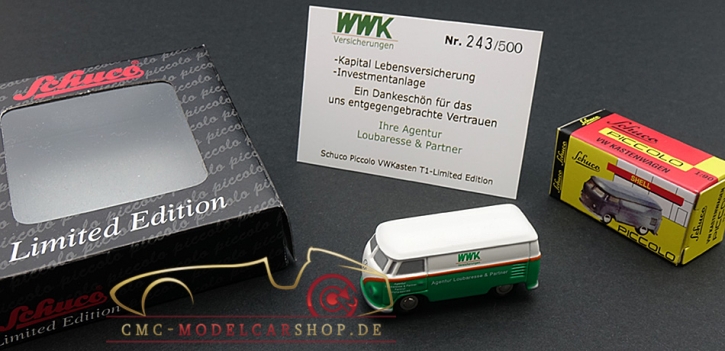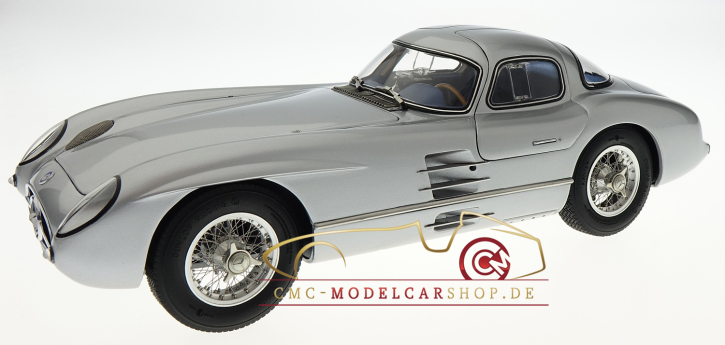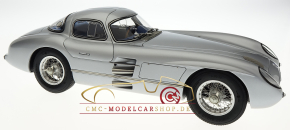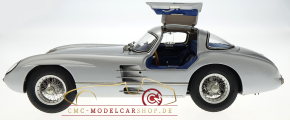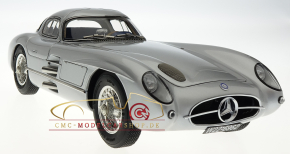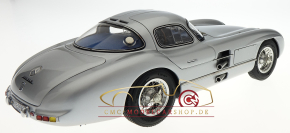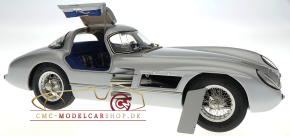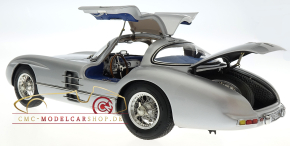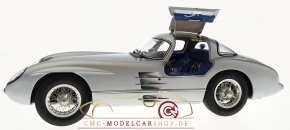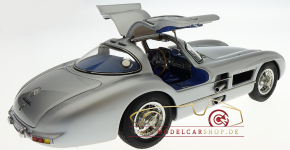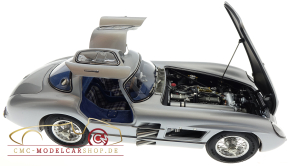559,00 EUR 623,00 EUR you save 10.3% (64,00 EUR)
incl. 19 % VAT excl. shipping costs
delivery time: 3-7 days within Germany
Product.Nr.: CMC M-243
product description
A masterpiece of architecture model:
CMC Mercedes-Benz 300 SLR Uhlenhaut Coupé, 1955, interior blue
When Rudolf Uhlenhaut, the architect of the 300 SLR racer, was at the 1955 Mille Miglia to watch Mercedes’ success, he was also mulling over the idea of fitting the 300 SLR racer with a closed top for endurance events in the future. His musings came to fruition in the shape of a competition coupé with the performance that no other road-going sports car could match. The two-seater recorded a speed of 290 km/h during a test on a closed section of motorway outside Munich.
When Rudolf Uhlenhaut, the architect of the 300 SLR racer, was at the 1955 Mille Miglia to watch Mercedes’ success, he was also mulling over the idea of fitting the 300 SLR racer with a closed top for endurance events in the future. His musings came to fruition in the shape of a competition coupé with the performance that no other road-going sports car could match. The two-seater recorded a speed of 290 km/h during a test on a closed section of motorway outside Munich.
Matching figure here:
Technical data of the CMC-model:
- Model: Precision model, hand-assembled
- Manufacturer: CMC GmbH, Classic Model Cars, Germany
- Scale: 1:18
- Item-No.: M-243
- Single parts: 1.817
- Limited Edition: ---
Model details:
- The "greenhouse" of this coupé resembles the cockpit of a plane. The seats are covered with checked cloth fabric.
- True to the original, the interior is covered with blue leather.
- The cockpit is complete with all instruments, control elements, switches and levers.l
- Everything is replicated faithfully to the real car
- Inside the trunk are two removable spare wheels, which are of different diameters, corresponding to those of the front and rear wheels respectively.
- The shiny side pipes, coming out of the air opening, are made of stainless steel. The cover of the maintenance opening can be removed. It is held in place by a simple but elegant magnetic mechanism.
- Highly-detailed and angular-installed 8-cylinder in-line-engine. All aggregates, pipes and cabling included. Support rod for the engine hood
- Abstützstange zur Fixierung der geöffneten Motorhaube
- Rotary flipper window, which is integrated inside the side window
- Hand-wired spokes, stainless-steel nipples, and aluminium rim
- A fine wire mesh protects the air inlet duct of the engine
- Removable three-wing central locking nuts and detachable wheels. The central locking nuts are so designed that they are side-specific.
- Detail-exact rear bodywork showing the Mercedes star, the 300 SLR type designation and the D-Logo
Description of the original vehicle:
When Rudolf Uhlenhaut, the architect of the 300 SLR racer, was at the 1955 Mille Miglia to watch Mercedes’ success, he was also mulling over the idea of fitting the 300 SLR racer with a closed top for endurance events in the future.
His musings came to fruition in the shape of a competition coupé with the performance that no other road-going sports car could match. The two-seater recorded a speed of 290 km/h during a test on a closed section of motorway outside Munich. Impressed by its extraordinary performance over a cross-country trek of 3500 km (over 2000 miles), the test reporter from the Swiss magazine Automobil Revue had this to say:
"We are driving a car which barely takes a second to overtake the rest of the traffic and for which 200 km/h on a quiet motorway is little more than talking pace. With its unflappable handling through corners, it treats the laws of centrifugal force with apparent disdain …"
The 300 SLR racer was based on the famous W196 Formula One champion of the 1954-55 season. The abbreviation SLR stands for Sport Light-Racing (Sport Leicht-Rennen). Considered one of the most beautiful racecars of all time, the new SLR was equipped with a slightly different straight-eight engine, which was expanded to displace 3 litres. Two of the nine 300 SLR rolling chassis, namely 0007/55 and 0008/55, were converted into 300 SLR Coupés with a closed-top body and gullwing doors. They were intended for the forthcoming Carrera Panamericana.
The body of the SLR coupé was panelled in sheet Elektron, a magnesium alloy that is even lighter than aluminum. The semicircular windscreen generated very little wind resistance. As in the SLR racer, the coupé driver had to control the pedals with his legs apart behind the steering wheel. Under the bonnet was a longitudinally-mounted eight-cylinder engine, which was placed just behind the front axle, developing peak torque of 234 lb-ft at 5950 rpm and a maximum output of 310 horsepower at 7400 rpm.
Owing to safety concerns following the tragic accident at Le Mans back in June, Mercedes-Benz decided to pull out of motorsport at the end of 1955. As a result, the SLR coupé project was shelved and never went into production. Subsequently, Rudolph Uhlenhaut appropriated one of the coupés, chassis for his personal use. Weighing only 1,117 km and capable of 290 km/h, the Uhlenhaut coupé was by far the fastest road car of its time in the world.
Although the 300 SLR coupés stopped short of racing seriously, chassis 0007/55 was no stranger to motorsport racing. After the 1955 Swedish Grand Prix, it showed up again at the RAC Tourist Trophy that took place at Dundrod, Northern Ireland on September 17, 1955.
His musings came to fruition in the shape of a competition coupé with the performance that no other road-going sports car could match. The two-seater recorded a speed of 290 km/h during a test on a closed section of motorway outside Munich. Impressed by its extraordinary performance over a cross-country trek of 3500 km (over 2000 miles), the test reporter from the Swiss magazine Automobil Revue had this to say:
"We are driving a car which barely takes a second to overtake the rest of the traffic and for which 200 km/h on a quiet motorway is little more than talking pace. With its unflappable handling through corners, it treats the laws of centrifugal force with apparent disdain …"
The 300 SLR racer was based on the famous W196 Formula One champion of the 1954-55 season. The abbreviation SLR stands for Sport Light-Racing (Sport Leicht-Rennen). Considered one of the most beautiful racecars of all time, the new SLR was equipped with a slightly different straight-eight engine, which was expanded to displace 3 litres. Two of the nine 300 SLR rolling chassis, namely 0007/55 and 0008/55, were converted into 300 SLR Coupés with a closed-top body and gullwing doors. They were intended for the forthcoming Carrera Panamericana.
The body of the SLR coupé was panelled in sheet Elektron, a magnesium alloy that is even lighter than aluminum. The semicircular windscreen generated very little wind resistance. As in the SLR racer, the coupé driver had to control the pedals with his legs apart behind the steering wheel. Under the bonnet was a longitudinally-mounted eight-cylinder engine, which was placed just behind the front axle, developing peak torque of 234 lb-ft at 5950 rpm and a maximum output of 310 horsepower at 7400 rpm.
Owing to safety concerns following the tragic accident at Le Mans back in June, Mercedes-Benz decided to pull out of motorsport at the end of 1955. As a result, the SLR coupé project was shelved and never went into production. Subsequently, Rudolph Uhlenhaut appropriated one of the coupés, chassis for his personal use. Weighing only 1,117 km and capable of 290 km/h, the Uhlenhaut coupé was by far the fastest road car of its time in the world.
Although the 300 SLR coupés stopped short of racing seriously, chassis 0007/55 was no stranger to motorsport racing. After the 1955 Swedish Grand Prix, it showed up again at the RAC Tourist Trophy that took place at Dundrod, Northern Ireland on September 17, 1955.
CMC Legal Disclaimer
The use of manufacturers’ names, symbols, type designations, and/or descriptions is solely for reference purposes. It does not imply that the CMC scale model is a product of any of these manufacturers.
The use of racing team and/or driver names, symbols, starting numbers, and/or descriptions is solely for reference purposes. Unless otherwise stated, it does not imply that the CMC scale model is a product of any of these racing teams/drivers or endorsed by any of them.
The use of racing team and/or driver names, symbols, starting numbers, and/or descriptions is solely for reference purposes. Unless otherwise stated, it does not imply that the CMC scale model is a product of any of these racing teams/drivers or endorsed by any of them.
Technical data of the original vehicle:
- 8-cylinder in-line-engine (installed in a 33° inclination to the right side)
- Direct fuel injection
- Desmodromic valve control (positively controlled valves)
- Chassis: wishbone in the front, one joint single hinged swing axle in the rear
- Displacement: 2,982 ccm
- Output: approx. 300 hp at 7,600 rpm.
- Top speed: approx. 300 km/h
- Wheel base: 2,370 mm
- Total length: 4,315 mm
More Mercedes-Benz from CMC Classic Model Cars
Product safety - Manufacturer information (GPSR)
CMC GmbH & Co. KG, Stuttgarter Str. 106, 70736 Fellbach
Contact: www.cmc-modelcars.de
Sicherheitshinweis / Consigne sécurité / Safety warning:
Sammlermodell - Nicht für Kinder unter 14 Jahren geeignet
Modèle de collection - Ne convient pas aux enfants de moins de 14 ans.
Collector's model - Not suitable for children under 14 years of age












